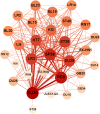Acupuncture for Major Depressive Disorder: A Data Mining-Based Literature Study
- PMID: 37159675
- PMCID: PMC10163884
- DOI: 10.2147/NDT.S405728
Acupuncture for Major Depressive Disorder: A Data Mining-Based Literature Study
Abstract
Introduction: Acupuncture has a long history of treating major depressive disorder (MDD), yet the acupoint selection of acupuncture for MDD varies greatly. This study aimed to explore the characteristics and principles of acupuncture for MDD by analyzing clinical trials of acupuncture for MDD using data mining techniques.
Methods: In this study, clinical trials of acupuncture for MDD were retrieved and relevant data were extracted, and then the data were analyzed by data mining techniques. In addition, association rule mining, network analysis and hierarchical cluster analysis were used to determine the correlation between different acupoints.
Results: The results revealed that GV20, LR3, PC6, SP6 and GV29 were used most frequently; acupoints in the Yang meridian were used more often than those in the Yin meridian, with the most applied acupoints in the Governor Vessel; the percentage of specific acupoints applied was 69.39%, with the most applied being five-shu points; the frequency of acupoints used was highest in the lower limbs, while the head, face, and neck had the most acupoints used; GV29 combined with GV20 were the most used acupoint groups; the core acupoints used for MDD were GV20, PC6 and SP36; there were 5 acupoint groups according to the cluster analysis. The most used acupuncture method was manual acupuncture; the frequency of treatment was mostly 7 times per week and the duration of treatment was mostly 42 days.
Discussion: We discussed the current character of acupuncture treatment on MDD, including the frequency used of acupoints, the property of used acupoints, the acupoint combination, the acupuncture method, and the frequency and duration of treatment. These findings may provide new ideas for the clinical treatment of MDD. However, further clinical/experimental studies are needed to demonstrate the significance of this concept and approach.
Keywords: acupuncture treatment; association rule mining; cluster analysis; data mining technology; network analysis.
© 2023 Tu et al.
Conflict of interest statement
There are no financial or other conflicts of interest between the principals of the entire trial and the principals of the individual study sites. The author reports no conflicts of interest in this work.
Figures
Similar articles
-
Investigating Acupoint Selection and Combinations of Acupuncture for Tic Disorders: An Association Rule Mining and Network Analysis Study.Front Neurol. 2022 Jun 10;13:894951. doi: 10.3389/fneur.2022.894951. eCollection 2022. Front Neurol. 2022. PMID: 35756940 Free PMC article.
-
Rules of acupoint selection in treatment of cancer-related insomnia with acupuncture and moxibustion based on data mining technology.Zhen Ci Yan Jiu. 2024 Jul 25;49(7):726-735. doi: 10.13702/j.1000-0607.20240085. Zhen Ci Yan Jiu. 2024. PMID: 39020491 Chinese, English.
-
[Analysis of regularity of acupoint selection and compatibility of acupuncture in the treatment of postpartum depression].Zhen Ci Yan Jiu. 2023 Mar 25;48(3):305-10. doi: 10.13702/j.1000-0607.20211295. Zhen Ci Yan Jiu. 2023. PMID: 36951085 Chinese.
-
[Analysis on clinical application characteristics of acupuncture and moxibustion in the treatment of Meniere's disease based on topology model by complex network].Zhen Ci Yan Jiu. 2022 Oct 25;47(10):918-26. doi: 10.13702/j.1000-0607.20210734. Zhen Ci Yan Jiu. 2022. PMID: 36301171 Chinese.
-
Acupoints for Tension-Type Headache: A Literature Study Based on Data Mining Technology.Evid Based Complement Alternat Med. 2021 Mar 12;2021:5567697. doi: 10.1155/2021/5567697. eCollection 2021. Evid Based Complement Alternat Med. 2021. PMID: 33777156 Free PMC article. Review.
Cited by
-
The efficacy and cerebral mechanism of intradermal acupuncture for major depressive disorder: a multicenter randomized controlled trial.Neuropsychopharmacology. 2025 Jun;50(7):1075-1083. doi: 10.1038/s41386-024-02036-5. Epub 2024 Dec 8. Neuropsychopharmacology. 2025. PMID: 39648209 Free PMC article. Clinical Trial.
-
A systematic review and coordinate-based meta-analysis of fMRI studies on acupuncture at LR 3.Front Neurosci. 2024 Jan 29;18:1341567. doi: 10.3389/fnins.2024.1341567. eCollection 2024. Front Neurosci. 2024. PMID: 38348133 Free PMC article.
-
Analysis of Acupoint Selection and Combinations in Acupuncture Treatment of Piriformis Syndrome: A Protocol for Data Mining.J Pain Res. 2023 Sep 28;16:3265-3272. doi: 10.2147/JPR.S422857. eCollection 2023. J Pain Res. 2023. PMID: 37790189 Free PMC article.
-
Acupoints for Headache with Blood Stasis Syndrome: a Literature Study Based on Data Mining Technology.J Pain Res. 2024 Jul 26;17:2455-2471. doi: 10.2147/JPR.S471441. eCollection 2024. J Pain Res. 2024. PMID: 39081327 Free PMC article. Review.
-
Optimizing Treatment for Major Depressive Disorder in Adolescents: The Impact of Intradermal Acupuncture - A Randomized Controlled Trial Protocol.Neuropsychiatr Dis Treat. 2023 Aug 23;19:1819-1832. doi: 10.2147/NDT.S420489. eCollection 2023. Neuropsychiatr Dis Treat. 2023. PMID: 37641586 Free PMC article.
References
LinkOut - more resources
Full Text Sources






